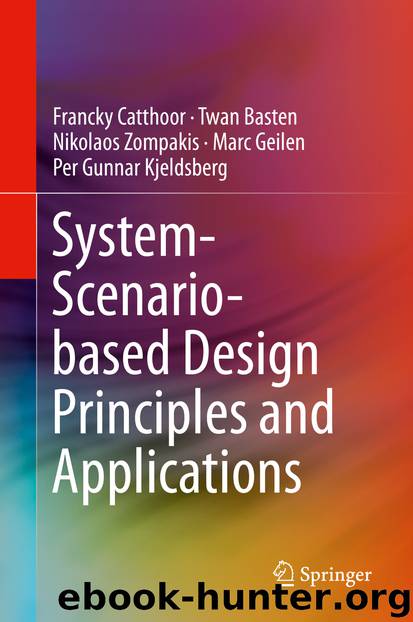System-Scenario-based Design Principles and Applications by Francky Catthoor & Twan Basten & Nikolaos Zompakis & Marc Geilen & Per Gunnar Kjeldsberg

Author:Francky Catthoor & Twan Basten & Nikolaos Zompakis & Marc Geilen & Per Gunnar Kjeldsberg
Language: eng
Format: epub
ISBN: 9783030203436
Publisher: Springer International Publishing
2 Auto-tuning of HPC Systems
Given that system-scenario-based design is fully covered in other chapters of this book, this section focuses on how dynamic behavior is handled in HPC systems.
While a small number of dynamic auto-tuning methodologies and tools existed for run-time optimizations [3, 20], there is currently no single standalone dynamic auto-tuning framework with the capability to target the full breadth of large-scale HPC applications being used in academia and industry, both now and on the road to Exascale.
Still, several EU research projects are approaching the challenge of tuning for performance and energy efficiency by either introducing entirely new programming models or leveraging existing prototype languages. An example of the latter is the ENabling technologies for a programmable many-CORE (ENCORE) project [5], which aims to achieve massive parallelism relying on tasks and efficient task scheduling using the OmpSs programming model [19]. The READEX project takes a different approach by developing a new generic programming paradigm, which allows to express and to utilize dynamism of applications in the automatic tuning process.
The Performance Portability and Programmability for Heterogeneous Many-core Architectures PEPPHER project [1] has developed a methodology and framework for programming and optimizing applications for single-node heterogeneous many-core processors to ensure performance portability. With Intel as a key partner in the project, READEX goes one step further and provides a framework that supports the heterogeneity of the system in the form of tuning parameters, which enable large-scale heterogeneous applications to dynamically (and automatically) adapt heterogeneous resources according to run-time requirements.
The ANTAREX project [18] creates a domain specific language (DSL), which distributes the code between multi-core CPUs and accelerators. An extra compilation step is introduced to translate the DSL into the intended programming language. While our work targets conventional HPC clusters, the ANTAREX project focuses on ARM-based systems.
Nowadays, most performance engineering tools focus on collecting and presenting information to the users, while only a few focus on the automation of the performance optimization process (auto-tuning). One example of the latter is the periscope tuning framework (PTF) developed in the EU FP7 ICT AutoTune project [2, 15]. PTF automatically finds optimized system configurations for whole application runs, effectively averaging the benefits of system adaptation over the whole run-time of the application (static tuning). With these static auto-tuning techniques, improvements in energy efficiency of up to 10% for application runs have been achieved while keeping the performance degradation to a few percent [4].
PTF’s main principles are the use of formalized expert knowledge and strategies, an extensible and modular architecture based on tuning plugins, automatic execution of experiments, and distributed, scalable processing. PTF provides a number of predefined tuning plugins, including: Dynamic voltage and frequency scaling (DVFS)
Download
System-Scenario-based Design Principles and Applications by Francky Catthoor & Twan Basten & Nikolaos Zompakis & Marc Geilen & Per Gunnar Kjeldsberg.epub
This site does not store any files on its server. We only index and link to content provided by other sites. Please contact the content providers to delete copyright contents if any and email us, we'll remove relevant links or contents immediately.
Linux Device Driver Development Cookbook by Rodolfo Giometti(3957)
Embedded Programming with Modern C++ Cookbook by Igor Viarheichyk(3783)
Implementing Cellular IoT Solutions for Digital Transformation by Dennis McCain(3703)
Embedded Linux Development Using Yocto Project - Third Edition by Otavio Salvador & Daiane Angolini(3551)
TinyML Cookbook by Gian Marco Iodice(3470)
Simplifying 3D Printing with OpenSCAD by Colin Dow(2861)
TinyML Cookbook by Gian Marco Iodice & Ronan Naughton(2623)
Fusion 360 for Makers by Lydia Sloan Cline(2231)
Networking A Beginner's Guide by Bruce Hallberg(2228)
Hands-On Linux for Architects by Denis Salamanca(2073)
But How Do It Know? by J. Clark Scott(2039)
Computers For Seniors For Dummies by Nancy C. Muir(2023)
Raspberry Pi and MQTT Essentials by Dhairya Parikh(1980)
Arduino Project Handbook, Volume 2: 25 Simple Electronics Projects for Beginners by Geddes Mark(1963)
9781803246888-ENHANCING DEEP LEARNING WITH BAYESIAN INFERENCE by Unknown(1918)
Hack and HHVM by Owen Yamauchi(1904)
31 Days Before Your CompTIA A+ Exams (Shanette Luellen's Library) by Benjamin Patrick Conry(1878)
MicroPython Projects by Jacob Beningo(1768)
Hands-On Internet of Things with MQTT by Tim Pulver(1729)
